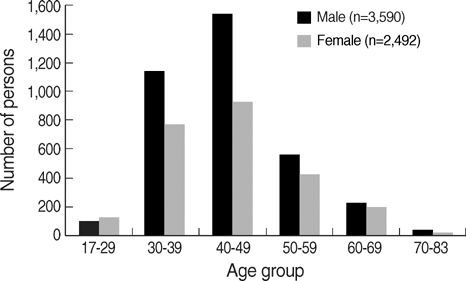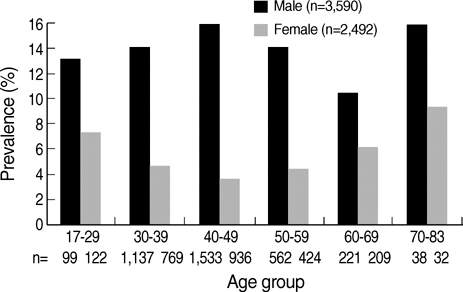J Korean Med Sci.
2009 Apr;24(2):197-202. 10.3346/jkms.2009.24.2.197.
The Prevalence and Clinical Characteristics of Reflux Esophagitis in Koreans and Its Possible Relation to Metabolic Syndrome
- Affiliations
-
- 1Department of Internal Medicine, Ewha Medical Research Institute, School of Medicine, Ewha Womans University, Seoul, Korea. shimkn@ewha.ac.kr
- KMID: 1779118
- DOI: http://doi.org/10.3346/jkms.2009.24.2.197
Abstract
- The prevalence of reflux esophagitis is increasing in Korea. To estimate the prevalence and clinical characteristics of reflux esophagitis in healthy subjects, we retrospectively examined the medical records of healthy subjects undergoing a routine check-up from October 2004 to September 2005. A total of 6,082 (3,590 men, mean age 44+/-10 yr) subjects were enrolled in this study. The prevalence of reflux esophagitis in healthy subjects was 10.5%. According to the univariate analysis, male sex (odds ratio [OR] 3.49, 95% confidence interval [CI] 2.84-4.30), smoking history (OR 1.91, 95% CI 1.60-2.28), body mass index (BMI) >30 kg/m2 (OR 2.13, 95% CI 1.37-3.33), total cholesterol >250 mg/dL (OR 1.50, 95% CI 1.05-2.14), low-density lipoprotein (LDL) cholesterol > or =160 mg/dL (OR 1.52, 95% CI 1.08-2.14), triglyceride > or =150 mg/dL (OR 1.92, 95% CI 1.61-2.30), high blood pressure (BP) (OR 1.46, 95% CI 1.20-1.76), and fasting glucose > or =110 mg/dL (OR 1.45, 95% CI 1.13-1.86) were significantly associated with reflux esophagitis (all p<0.05). However, age, alcohol drinking and Helicobacter pylori infection were not associated with reflux esophagitis. In conclusiosn, significant relationships of reflux esophagitis with obesity, low high-density lipoprotein (HDL) cholesterol, high triglyceride, high BP, and elevated fasting glucose suggested that reflux esophagitis might represent the disease spectrum of the metabolic syndrome.
Keyword
MeSH Terms
Figure
Cited by 1 articles
-
Gender Specific Differences in Prevalence and Risk Factors for Gastro-Esophageal Reflux Disease
Sang Yoon Kim, Hye-Kyung Jung, Jiyoung Lim, Tae Oh Kim, A Reum Choe, Chung Hyun Tae, Ki-Nam Shim, Chang Mo Moon, Seong-Eun Kim, Sung-Ae Jung
J Korean Med Sci. 2019;34(21):. doi: 10.3346/jkms.2019.34.e158.
Reference
-
1. Inamori M, Togawa J, Nagase H, Abe Y, Umezawa T, Nakajima A, Saito T, Ueno N, Tanaka K, Sekihara H, Kaifu H, Tsuboi H, Kayama H, Tominaga S, Nagura H. Clinical characteristics of Japanese reflux esophagitis patients as determined by Los Angeles classification. J Gastroenterol Hepatol. 2003. 18:172–176.
Article2. Goh KL, Chang CS, Fock KM, Ke M, Park HJ, Lam SK. Gastrooesophageal reflux disease in Asia. J Gastroenterol Hepatol. 2000. 15:230–238.
Article3. Furukawa N, Iwakiri R, Koyama T, Okamoto K, Yoshida T, Kashiwagi Y, Ohyama T, Noda T, Sakata H, Fujimoto K. Proportion of reflux esophagitis in 6010 Japanese adults: prospective evaluation by endoscopy. J Gastroenterol. 1999. 34:441–444.
Article4. Yeh C, Hsu CT, Ho AS, Sampliner RE, Fass R. Erosive esophagitis and Barrett's esophagus in Taiwan: a higher frequency than expected. Dig Dis Sci. 1997. 42:702–706.5. Lee SJ, Song CW, Jeen YT, Chun HJ, Lee HS, Um SH, Lee SW, Choi JH, Kim CD, Ryu HS, Hyun JH. Prevalence of endoscopic reflux esophagitis among Koreans. J Gastroenterol Hepatol. 2001. 16:373–376.
Article6. Yeom JS, Park HJ, Cho JS, Lee SI, Park IS. Reflux esophagitis and its relationship to hiatal hernia. J Korean Med Sci. 1999. 14:253–256.7. Miranda PJ, DeFronzo RA, Califf RM, Guyton JR. Metabolic syndrome: definition, pathophysiology, and mechanisms. Am Heart J. 2005. 149:33–45.
Article8. Hongo M. Minimal changes in reflux esophagitis: red ones and white ones. J Gastroenterol. 2006. 41:95–99.
Article9. Sandler RS, Everhart JE, Donowitz M, Adams E, Cronin K, Goodman C, Gemmen E, Shah S, Avdic A, Rubin R. The burden of selected digestive diseases in the United States. Gastroenterology. 2002. 122:1500–1511.
Article10. Hampel H, Abraham NS, El-Serag HB. Meta-analysis: obesity and the risk for gastroesophageal reflux disease and its complications. Ann Intern Med. 2005. 143:199–211.
Article11. Kim Y, Suh YK, Choi H. BMI and metabolic disorders in South Korean adults: 1998 Korea National Health and Nutrition Survey. Obes Res. 2004. 12:445–453.
Article12. Kim DM, Ahn CW, Nam SY. Prevalence of obesity in Korea. Obes Rev. 2005. 6:117–121.
Article13. Nilsson M, Lundegardh G, Carling L, Ye W, Lagergren J. Body mass and reflux oesophagitis: an oestrogen-dependent association? Scand J Gastroenterol. 2002. 37:626–630.
Article14. Nilsson M, Johnsen R, Ye W, Hveem K, Lagergren J. Obesity and estrogen as risk factors for gastroesophageal reflux symptoms. JAMA. 2003. 290:66–72.
Article15. Gudlaugsdottir S, Verschuren W, Dees J, Stijnen T, Wilson J. Hypertension is frequently present in patients with reflux esophagitis or Barrett's esophagus but not in those with non-ulcer dyspepsia. Eur J Intern Med. 2002. 13:369–375.
Article16. Pilotto A, Franceschi M, Leandro G, Scarcelli C, D'Ambrosio LP, Seripa D, Perri F, Niro V, Paris F, Andriulli A, Di Mario F. Clinical features of reflux esophagitis in older people: a study of 840 consecutive patients. J Am Geriatr Soc. 2006. 54:1537–1542.
Article17. Lind T, Havelund T, Carlsson R, Anker-Hansen O, Glise H, Hernqvist H, Junghard O, Lauritsen K, Lundell L, Pedersen SA, Stubberod A. Heartburn without oesophagitis: efficacy of omeprazole therapy and features determining therapeutic response. Scand J Gastroenterol. 1997. 32:974–979.
Article18. Behar J, Biancani P, Sheahan DG. Evaluation of esophageal tests in the diagnosis of reflux esophagitis. Gastroenterology. 1976. 71:9–15.
Article19. Hongo M, Traube M, McAllister RG Jr, McCallum RW. Effects of nifedipine on esophageal motor function in humans: correlation with plasma nifedipine concentration. Gastroenterology. 1984. 86:8–12.
Article20. Nishida T, Tsuji S, Tsujii M, Arimitsu S, Sato T, Haruna Y, Miyamoto T, Kanda T, Kawano S, Hori M. Gastroesophageal reflux disease related to diabetes: analysis of 241 cases with type 2 diabetes mellitus. J Gastroenterol Hepatol. 2004. 19:258–265.
Article21. Kinekawa F, Kubo F, Matsuda K, Inoue H, Kuriyama S. Gastroesophageal reflux disease in diabetic patients. Nippon Rinsho. 2004. 62:1546–1552.22. Lluch I, Ascaso JF, Mora F, Minguez M, Pena A, Hernandez A, Benages A. Gastroesophageal reflux in diabetes mellitus. Am J Gastroenterol. 1999. 94:919–924.
Article23. Rayner CK, Samsom M, Jones KL, Horowitz M. Relationships of upper gastrointestinal motor and sensory function with glycemic control. Diabetes Care. 2001. 24:371–381.
Article24. De Boer SY, Masclee AA, Lam WF, Lamers CB. Effect of acute hyperglycemia on esophageal motility and lower esophageal sphincter pressure in humans. Gastroenterology. 1992. 103:775–780.
Article25. Ford ES, Giles WH, Dietz WH. Prevalence of the metabolic syndrome among US adults: findings from the third National Health and Nutrition Examination Survey. JAMA. 2002. 287:356–359.
Article26. Miyatake N, Wada J, Kawasaki Y, Nishii K, Makino H, Numata T. Relationship between metabolic syndrome and cigarette smoking in the Japanese population. Intern Med. 2006. 45:1039–1043.
Article27. Park HS, Lee SY, Kim SM, Han JH, Kim DJ. Prevalence of the metabolic syndrome among Korean adults according to the criteria of the International Diabetes Federation. Diabetes Care. 2006. 29:933–934.
Article28. Wassink AM, Olijhoek JK, Visseren FL. The metabolic syndrome: metabolic changes with vascular consequences. Eur J Clin Invest. 2007. 37:8–17.
Article29. Corley DA, Kubo A. Body mass index and gastroesophageal reflux disease: a systematic review and meta-analysis. Am J Gastroenterol. 2006. 101:2619–2628.
Article30. El-Serag HB, Graham DY, Satia JA, Rabeneck L. Obesity is an independent risk factor for GERD symptoms and reflux esophagitis. Am J Gastroenterol. 2005. 100:1243–1250.31. Moki F, Kusano M, Mizuide M, Shimoyama Y, Kawamura O, Takagi H, Imai T, Mori M. Association between reflux esophagitis and features of the metabolic syndrome in Japan. Aliment Pharmacol Ther. 2007. 26:1069–1075.
- Full Text Links
- Actions
-
Cited
- CITED
-
- Close
- Share
- Similar articles
-
- The prevalence and associated factors of reflux esophagitis in routine check-up subjects
- Prevalence and Clinical Characteristics of Noncardiac Chest Pain with Reflux Esophagitis in Korea
- The Role of Helicobacter Pylori Infection in Reflux Esophagitis
- Prevalence of Tropheryma whippelii DNA in Patients with Reflux Esophagitis or Irritable Bowel Syndrome
- Reflux esophagitis and its relationship to hiatal hernia



